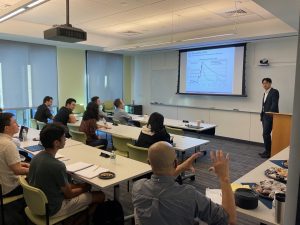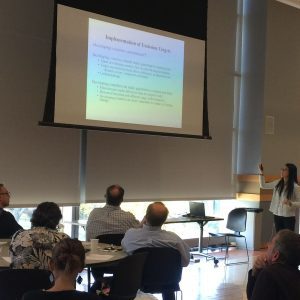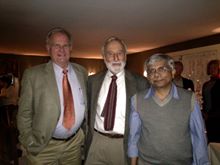I’ve been asked to let you know what’s been going on since I left the Department. This is the first in what may turn out to be occasional “where-are-they-now” entries from emeritus professors. If you have read this UConn Econ Blog much, you know it’s usually written in the third person (it’s not so much a blog as a bulletin board). Writing in the third person is good for keeping up with those who don’t want to toot their own horn (or who don’t want to appear to be tooting their own horn). But the first person works better for me.
Even though I taught more than ten thousand students at UConn and worked alongside more than one hundred TAs, I am probably a stranger to current students. So please bear with me through this one paragraph of background. In 1973 Dennis Heffley and I joined the faculty. Bill Lott had already been on board three years. In 1981, I was appointed the Department’s first official Director of Graduate Studies. One promising graduate applicant at the time was a Wesleyan student named Thomas Miceli. He turned down our fellowship offer, choosing Brown instead. (Mmmm…I wonder what ever happened to him?) I regularly taught the graduate course in State and Local Finance. Students taking that course included Rex Santerre, now a UConn finance professor, John DeStefano, now New Haven’s long-serving mayor, Barry Feldman, now UConn’s VP and COO, and David Stockton, now head of research for the Federal Reserve Board in Washington, where he oversees a dozen divisions and more than a hundred Ph.D.s. Along the way, I also received the UConn Alumni Association’s Distinguished Public Service Award and later its Excellence in Undergraduate Teaching Award.
I decided to retire from UConn after my wife left me. But let’s back up a bit. In the late 1990s, Pat had a wonderful opportunity to run Aetna’s Hong Kong insurance business, an operation with thousands of employees and some interesting challenges in light of Hong Kong’s reversion from Great Britain to China. But I was then in the middle of several projects and couldn’t leave. So we agreed that she would move to Hong Kong, I would remain in Connecticut, and we would have a commuter marriage.
One good thing about living twelve time zones apart is that we could meet at either end or anywhere in between. Besides reunions in Hong Kong and Connecticut, we got together in Orlando, Las Vegas, Phoenix, London, and Tokyo. But all that jet-setting gets old fast when you want to be together (parting may be “sweet sorrow,” but it’s still parting and still sad). So in 2000, I decided to take early retirement to join Pat in Hong Kong. It wasn’t that I disliked my teaching, my research, my students, or my colleagues. We just wanted to be together.
We lived in a high rise on Hong Kong Island, within walking distance to just about everything (the only thing within walking distance of our Willington home was the mail box, and that was some walk). One opportunity turned into another for Pat, and she joined Sun Life Insurance as head of investments for its Asia operations. She was based in Hong Kong and responsible for company investments there as well as Mainland China, India, Indonesia, and the Philippines (all developing economies, to be sure, but they comprise more than a third of the world’s population). She traveled a lot to those countries on business, and together we traveled for fun to Mainland China, Taiwan, India, Vietnam, Thailand, Singapore, Indonesia, and Japan. We also flew to Egypt and cruised down the Nile.
Hong Kong was a once-in-a-lifetime experience, but the longer we were away, the more we missed America, especially the clearer air (pollution poured into Hong Kong from factories in Southern China). So after Pat had spent about six years in Hong Kong (and I, about four and a half), we decided to return to the United States. But where to live? Our Hong Kong experience framed that choice—warm climate, high-rise living, and within walking distance of most activities. Because Pat, who grew up in Arizona, had spent nearly three decades braving New England winters with me, we decided on a warmer climate in general and on Phoenix in particular. We returned to the U.S. in 2007 and now live on the 12th floor of a high-rise condominium in the Biltmore area of Phoenix.
We love it here. I’m attaching a photo taken just as we were leaving for Starbucks, which is only a hundred yards away. Sure the summers are hot, but that’s a good time to travel, and the low humidity makes it more hospitable for us than in Hong Kong, which at times could be really oppressive. Again, it’s all framing. We still run for an hour six mornings a week and try to stay in working order.
Pat is now on what she calls a “career break,” and she enjoys the free time. Since leaving UConn, I revised my principles of economics textbook for seventh and eighth editions and am now beginning a ninth. I continue writing The Teaching Economist, my newsletter for college teachers, and I’ve managed to publish some other research. Also, my National Tax Journal piece on the median-voter model was selected for inclusion in the edited volume Public Choice Economics published by the University of Michigan Press (others in that volume include some heroes of mine—Mancur Olson, Ray Fair, Avinash Dixit & Barry Nalebuff, Gordon Tullock, James Buchanan, and Dennis Mueller).
My principles textbook has been translated into Chinese, Bahasa Indonesia, and Spanish (twice), and an Australian adaptation is in its third edition. Micro and Macro versions of the book were also selected as the economics principles entries for Cengage Learning’s Four Letter Press series (they had a dozen principles books to choose from). I worked on those adaptations, which just appeared in second editions as ECON Micro 2 and ECON Macro 2. Finally, shortly after I left UConn, I was asked to write a principles textbook for high school students; I did that and later revised the book for a second edition; a third edition is scheduled for 2011.
I try to keep in touch with colleagues and former students, but I could do a lot better. I’d be glad to hear from you at william.mceachern@uconn.edu. Also look for Pat and me at the January ASSA meetings in Atlanta.
What an interesting time to be an economist!
 With support from the Art Wright Seminar Fund, Dr. Dong Hwan Oh, a senior economist and quantitative risk analyst at the Division of Reserve Bank Operations and Payment Systems of Board of Governors of the Federal Reserve System, spoke at the departmental Econometrics Seminar on Friday, October 7th.
With support from the Art Wright Seminar Fund, Dr. Dong Hwan Oh, a senior economist and quantitative risk analyst at the Division of Reserve Bank Operations and Payment Systems of Board of Governors of the Federal Reserve System, spoke at the departmental Econometrics Seminar on Friday, October 7th.

